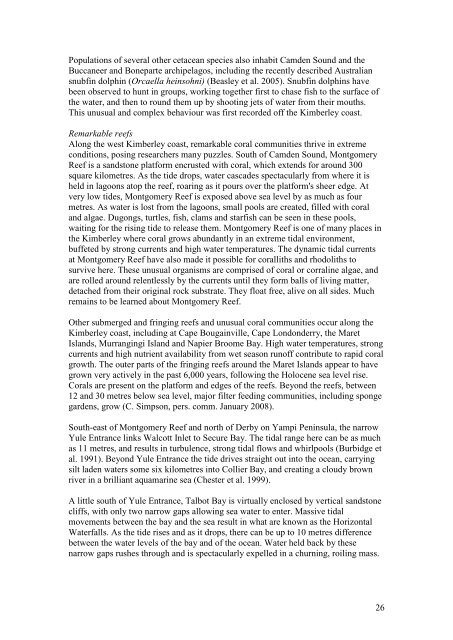WEST KIMBERLEY PLACE REPORT - Department of Sustainability ...
WEST KIMBERLEY PLACE REPORT - Department of Sustainability ...
WEST KIMBERLEY PLACE REPORT - Department of Sustainability ...
You also want an ePaper? Increase the reach of your titles
YUMPU automatically turns print PDFs into web optimized ePapers that Google loves.
Populations <strong>of</strong> several other cetacean species also inhabit Camden Sound and the<br />
Buccaneer and Boneparte archipelagos, including the recently described Australian<br />
snubfin dolphin (Orcaella heinsohni) (Beasley et al. 2005). Snubfin dolphins have<br />
been observed to hunt in groups, working together first to chase fish to the surface <strong>of</strong><br />
the water, and then to round them up by shooting jets <strong>of</strong> water from their mouths.<br />
This unusual and complex behaviour was first recorded <strong>of</strong>f the Kimberley coast.<br />
Remarkable reefs<br />
Along the west Kimberley coast, remarkable coral communities thrive in extreme<br />
conditions, posing researchers many puzzles. South <strong>of</strong> Camden Sound, Montgomery<br />
Reef is a sandstone platform encrusted with coral, which extends for around 300<br />
square kilometres. As the tide drops, water cascades spectacularly from where it is<br />
held in lagoons atop the reef, roaring as it pours over the platform's sheer edge. At<br />
very low tides, Montgomery Reef is exposed above sea level by as much as four<br />
metres. As water is lost from the lagoons, small pools are created, filled with coral<br />
and algae. Dugongs, turtles, fish, clams and starfish can be seen in these pools,<br />
waiting for the rising tide to release them. Montgomery Reef is one <strong>of</strong> many places in<br />
the Kimberley where coral grows abundantly in an extreme tidal environment,<br />
buffeted by strong currents and high water temperatures. The dynamic tidal currents<br />
at Montgomery Reef have also made it possible for coralliths and rhodoliths to<br />
survive here. These unusual organisms are comprised <strong>of</strong> coral or corraline algae, and<br />
are rolled around relentlessly by the currents until they form balls <strong>of</strong> living matter,<br />
detached from their original rock substrate. They float free, alive on all sides. Much<br />
remains to be learned about Montgomery Reef.<br />
Other submerged and fringing reefs and unusual coral communities occur along the<br />
Kimberley coast, including at Cape Bougainville, Cape Londonderry, the Maret<br />
Islands, Murrangingi Island and Napier Broome Bay. High water temperatures, strong<br />
currents and high nutrient availability from wet season run<strong>of</strong>f contribute to rapid coral<br />
growth. The outer parts <strong>of</strong> the fringing reefs around the Maret Islands appear to have<br />
grown very actively in the past 6,000 years, following the Holocene sea level rise.<br />
Corals are present on the platform and edges <strong>of</strong> the reefs. Beyond the reefs, between<br />
12 and 30 metres below sea level, major filter feeding communities, including sponge<br />
gardens, grow (C. Simpson, pers. comm. January 2008).<br />
South-east <strong>of</strong> Montgomery Reef and north <strong>of</strong> Derby on Yampi Peninsula, the narrow<br />
Yule Entrance links Walcott Inlet to Secure Bay. The tidal range here can be as much<br />
as 11 metres, and results in turbulence, strong tidal flows and whirlpools (Burbidge et<br />
al. 1991). Beyond Yule Entrance the tide drives straight out into the ocean, carrying<br />
silt laden waters some six kilometres into Collier Bay, and creating a cloudy brown<br />
river in a brilliant aquamarine sea (Chester et al. 1999).<br />
A little south <strong>of</strong> Yule Entrance, Talbot Bay is virtually enclosed by vertical sandstone<br />
cliffs, with only two narrow gaps allowing sea water to enter. Massive tidal<br />
movements between the bay and the sea result in what are known as the Horizontal<br />
Waterfalls. As the tide rises and as it drops, there can be up to 10 metres difference<br />
between the water levels <strong>of</strong> the bay and <strong>of</strong> the ocean. Water held back by these<br />
narrow gaps rushes through and is spectacularly expelled in a churning, roiling mass.<br />
26
















